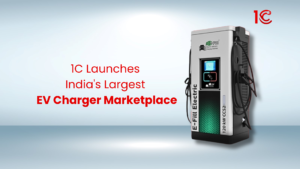
1C launches nation's largest EV charger marketplace, bringing chargers from renowned OEMs under a singlemplatform, offering convenience & options for EV owners.

With all the buzz surrounding electric, fuel, and hybrid vehicles, the term internal combustion engine or ICE is another word that comes into the queue. So, how exactly does this ICE technology operate in vehicles, and what role does it play in the shift towards Electric Vehicles? Internal Combustion Engines are an important part of Hybrid Vehicles, where the synergy of fuel and electricity takes centre stage. To understand the workings, advantages, and disadvantages of an internal combustion engine, we must understand what ICE is.
An internal combustion engine (ICE or IC engine) is an engine where fuel burns inside the cylinder. This engine can use different fuels like gasoline, diesel, hydrogen, methane, or propane.
The engine squeezes a mix of air and fuel, usually gasoline or diesel, in the cylinder. This mix then explodes either with a spark plug or through compression. This controlled explosion creates high pressure and temperature, pushing the engine piston and making it move. This movement converts the fuel’s energy into mechanical power, moving the vehicle.
Internal combustion engines are often used in things like motorcycles, buses, trucks, and even generators. They are efficient, with thermal efficiency ranging from 35% to 45%. Some examples include petrol engines, diesel engines, two-stroke engines, four-stroke engines, and more.
Fuel burns inside an internal combustion (IC) engine to make power. The engine changes the fuel’s heat into a turning motion. The IC engine includes a crankshaft, camshaft, piston, and a fixed cylinder.
1. Suction Stroke: The engine pulls air from the surroundings into the compression cylinder.
2. Compression Stroke: After pulling in air, the piston in the compression cylinder squeezes the air to make it hot. When the fuel mixes with this hot air, it automatically catches fire, producing power.
3. Expansion/Power Stroke: After burning, the air-fuel mix goes through an expansion valve, expanding it. This expansion pushes the piston up and down. The piston’s movement turns the crankshaft, moving the vehicle’s wheels.
4. Exhaust Stroke: In this stroke, the engine pushes out the used-up gases
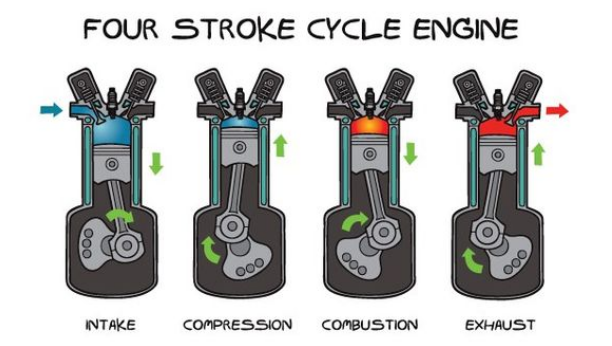
Various types of internal combustion engines exist, but the two primary ones are Gasoline engine and Diesel Engine.
For electric or hybrid vehicles, the most common type of internal combustion engine used is the Gasoline Engine. Hybrid vehicles typically have a combination of an internal combustion engine (gasoline) and an electric motor. The electric motor works alongside the gasoline engine to improve fuel efficiency and reduce emissions. In contrast, fully electric vehicles rely solely on electric motors and do not have an internal combustion engine.
A gasoline engine, also known as a spark-ignition engine, is a type of internal combustion engine that runs on gasoline fuel. Here’s a simple breakdown of how it works:
Gasoline engines are commonly used in cars, motorcycles, and small vehicles. They are known for their smooth operation and quick acceleration.
A diesel engine is another type of internal combustion engine that uses diesel fuel. Here’s a simplified explanation:
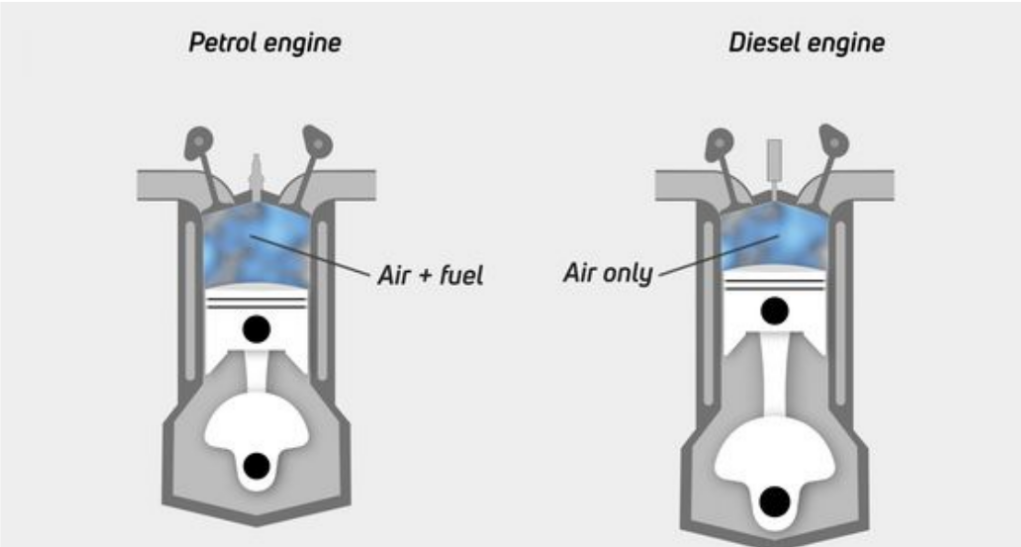
Diesel engines are often found in larger vehicles such as trucks, buses, and some cars. They are known for their fuel efficiency and high torque, making them suitable for heavy-duty applications.
The Internal Combustion Engine (ICE) is used in various ways:
Despite their usefulness, ICEs have drawbacks. They emit harmful substances, like nitrogen oxides and carbon monoxide, causing air pollution and contributing to climate change. Additionally, ICEs need frequent maintenance and can be noisy and inefficient at low speeds.
In electric vehicles, the term ‘ICE’ refers to an Internal Combustion Engine, but in the context of EVs, it is not used for propulsion. Instead, it is used for range extender or backup power source.
Some hybrid electric vehicles and plug-in hybrid electric vehicles incorporate a small internal combustion engine alongside an electric motor and a battery. This ICE serves as a generator to recharge the battery or provide additional power when needed. Here’s a simple explanation:
This setup increases the efficiency and reduces reliance on the ICE, particularly for short trips where the electric motor and battery alone might be sufficient. It provides the benefits of an electric drive with the flexibility of a backup power source. However, fully electric vehicles (BEVs) do not have an internal combustion engine and they only depend on electric motors which are powered by batteries.
Feature | Internal Combustion Engine (ICE) | External Combustion Engine |
Combustion Location | Combustion occurs inside the engine | Combustion occurs outside the engine |
Fuel Type | Gasoline, diesel, or alternative fuels | fossil fuels (coal, wood) |
Working Principle | The fuel-air mixture ignites inside the cylinder | The heat generated externally to produce steam |
Examples | Gasoline engines, diesel engines | Steam engines, Stirling engines |
Efficiency | higher efficiency | lower efficiency |
Size and Weight | Compact and lightweight | Often larger and heavier |
Application | Common in automobiles, aircraft, marine, etc. | Historically used in steam trains, some power plants |
Response Time | quick response time | Slow response time |
Pollution Emissions | It produce pollutants like nitrogen oxides and carbon monoxide | Low emissions due to controlled combustion |
Maintenance | Generally requires regular maintenance | Maintenance can be less frequent |
Noise Levels | It can be noisy, especially at high speeds | Generally quieter operation |
Noise and Vibration: Internal combustion engines can introduce noise and vibration, which are often more pronounced compared to the quiet and smooth operation of electric motors.
Internal Combustion engines are used in various fields like agriculture, vehicles, marines, planes etc. While it is efficient, its environmental impact and dependence on fossil fuels are growing concerns. In Electric Vehicles, ICEs are sometimes integrated as range extenders, enhancing versatility. Yet, using internal combustion engines in EVs brings challenges and pollution that go against the clean ideals of EV technology. As the car industry moves towards sustainability, figuring out how to make internal combustion engines work in electric cars without causing problems requires continuous thought and technological progress. It’s essential for creating a balanced and good future for the environment.
1C launches nation's largest EV charger marketplace, bringing chargers from renowned OEMs under a singlemplatform, offering convenience & options for EV owners.
Optimal location for urban EV charging stations include high-traffic areas, residential zones, business districts, transit hubs, and leisure destinations.
Explore the surprisingly long history of electric vehicles. Start from 1830s with dawn of EVs, go through 1900s when electric cars dominated the roads, move through the 60s, when ICE rose to popularity, and cruise through the 21st century to understand the rebirth of electric vehicle in automobile industry.
Can you charge your EV to 80% in 10 minutes? Discover the truth about fast charging and how 1C helps you find verified stations. Stay informed & charge wisely!
Understand the cost of setting up an EV charging station in India. Learn about setup costs, operational expenses, and the future viability of the plan.
Streamline your EV charging with the 1C EV Charging App: 1 app, 250+ verified chargers, real-time data, and a user-friendly experience. Download now!
Why 1C EV Charging CMS is Among the Best in India What is a CMS It is software that lets you control
Avoid common EV charging mistakes like aiming for 100% every time or letting the battery die. Simple habits like maintaining a 20-80% charge and planning charging stops can extend your battery life.


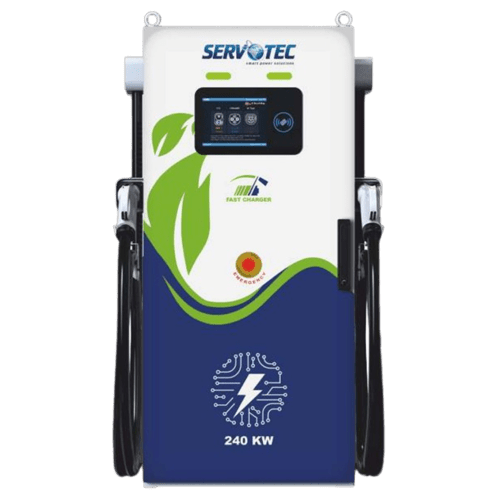
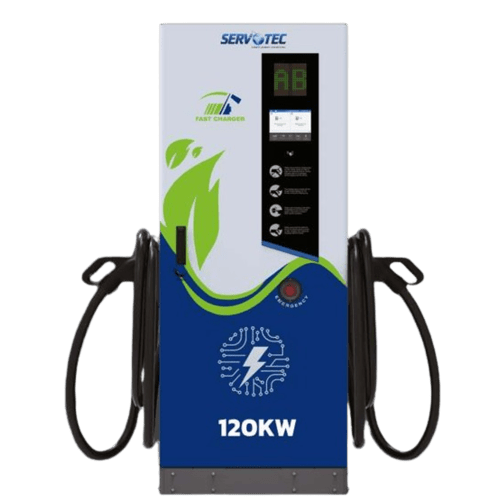
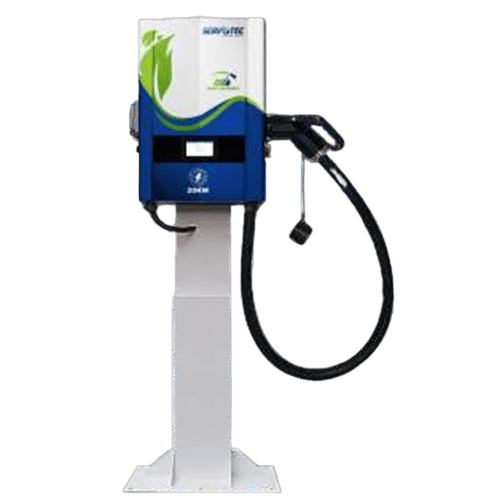
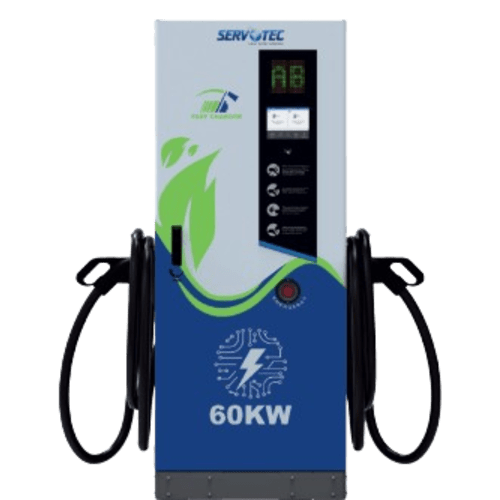
© 2024 Massive Mobility Private Limited. All rights Reserved